I happened to give the Fallout series a try. The video game series started in 1997, but it was until this year 2017 that I began to play Fallout 4 (released in 2015). The game was beyond my expectation of what defines a good game. It has an interesting storyline, fantastic game mechanism, and a massive open world to explore. To sustain my enjoyment, I continued with Fallout: New Vegas( released in 2010). It was when I came across a thought-provoking story of Vault 11.
In general, the Fallout series is set in the United States in a fictional post-apocalyptic world that emerges right after World War II. Assuming that a nuclear exchange between Communist China and the United States has taken place in 2077, the entirety of human civilization is destroyed, only a few survive the wasteland of North America, along with mutated creatures, without a functioning government to maintain order. Before the nuclear strikes, US government has teamed up with Vault-Tec, a company funded to built underground fallout shelters, or “vaults,” for inhabitants to survive a nuclear winter with a hope that one day they could re-populate the United States again. However, Vault projects never carry good intentions. They were actually secret social experiments, each was designed differently to test its inhabitants psychologically, physically and morally in extreme scenarios. As a result, most Vault experiments do not end up well, given that there is no one from Vault-Tec or U.S government alive to inspect and evaluate the outcomes. In hundreds of vaults waiting to be discovered, each having different backstories, or “lore,” the story behind Vault 11 morally haunts me.
In the year 2281 (204 years since the nuclear strikes in 2077), I, a random adventurer from the Wasteland, came across an opened Vault. In the entrance, four skeletons are lying on the floor and a hollow tape of a conversation among a group of five people. Four of them argue they do not deserve to leave the vault, after “everything that happened,” and that there is nothing outside of the Vault anyway except a radiated wasteland. Hence, the four advocated a final solution: suicide. Only one of them has the desire to leave, intending to let other people know “what happened” and learn from “it.” The conversation ends with gunshots, the four commits suicide. The sole survivor whimpers and walks away out of the Vault to the Wasteland.
Background
The leaders of each vault are called “overseers.”
In Vault 11, it is said that each year, a member of the vault population must be sacrificed. This law is implemented by a computer that controls every aspect of the in-vault environment such as food, water, and air. In the event that the residents refuse to comply, that is, not sacrificing one of their fellows, the computer would kill all vault dwellers.
Before entering and being sealed in Vault 11, no one but the overseer knows about this horrible obligation. The vault community is shock and mad at the overseer. They condemn the overseer to be the first sacrifice, forcing him to enter the sacrificial chamber below the Overseer’s Office to be killed by the vault computer (thus satisfying the sacrificial condition and avoiding punishment). This event becomes a precedent for the vault to merge the Overseer position with the sacrificed. Since then, the vault population holds an annual election for all residents to vote for a candidate to become the overseer. Additionally, at the end of the overseer’s term, he or she will be sacrificed to the computer: going to the Sacrificial Chamber (the vault computer does not require the overseer to be the sacrifice, but the population makes it this way because of the precedent; how the person is sacrificed is not known by anyone).
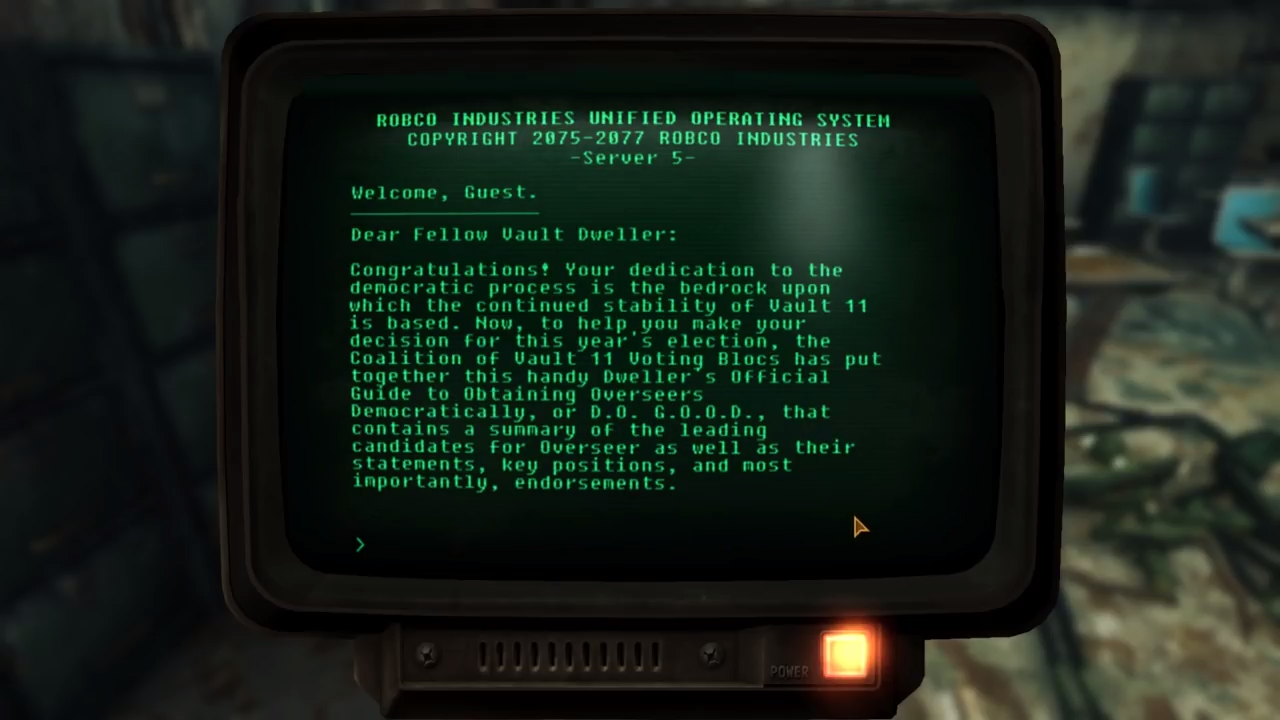
Democracy in Reverse
Being an overseer, the position that supposedly holds absolute power in the vault becomes more or less like a curse that is cast upon an unfortunate individual of the vault. Therefore, campaigns for the annual election turn out to be opportunities for candidates to persuade the public NOT to vote for him or her. And new voting blocs emerge to nominate the best candidate of the OTHER blocs (but actually the one that outrages the whole community by any reason) for the overseer position. The six voting blocs, United Vault Technician Bloc, Allied Service Workers Bloc, Divine Will Bloc, Human Dignity Bloc, Utilitarian Bloc and Justice Bloc, thus, actively pursue promotional campaigns to nominate a candidate outside of their bloc. Among them, the Justice Bloc is the most powerful one. Holding a narrow majority of the vault election, the Justice Bloc’s victim of nomination is very likely to become the overseer.
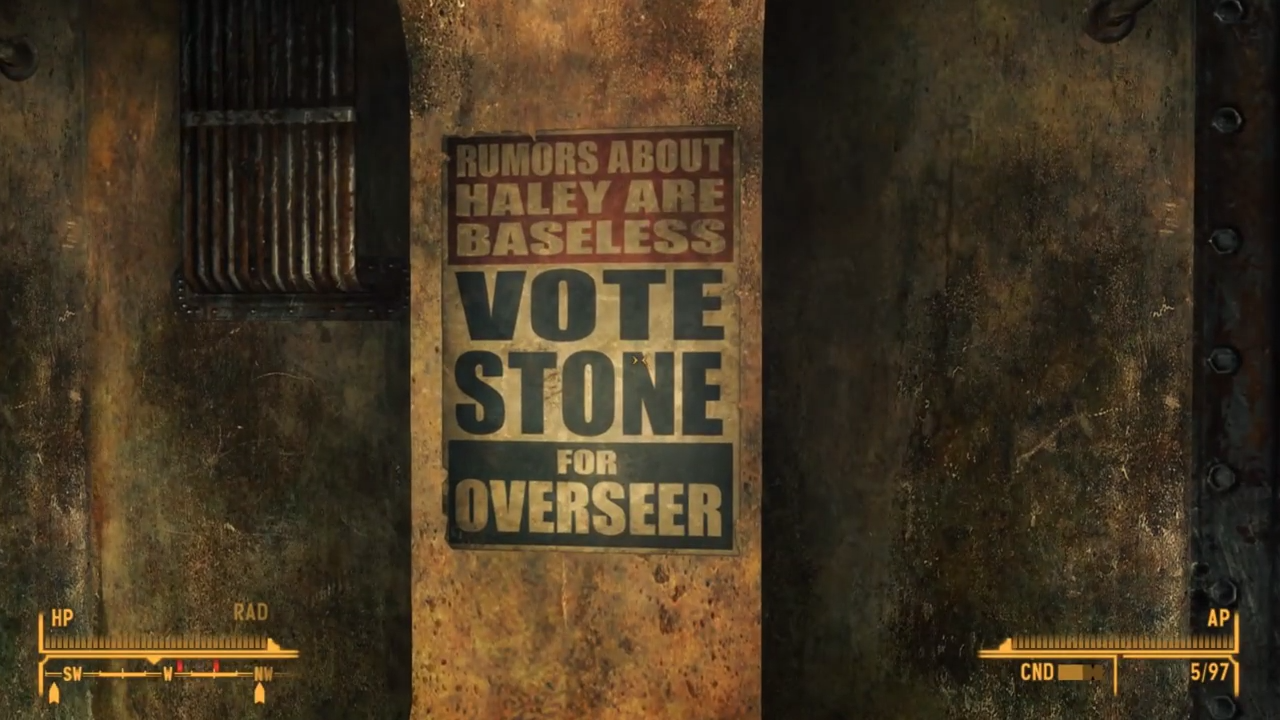
It all starts when Nathan Stone becomes the enemy of the Justice Bloc for his winning streak during poker games against the members of this bloc. Then, Roy Gottlieb, leader of the Justice Bloc confronts Katherine Stone, Nathan’s wife, and threatens to nominate Nathan for the overseer position in the upcoming election unless she performs sexual favors to every member of the Justice Bloc. Knowing her husband would be offered as a sacrifice to the computer, Katherine complies. However, during the election, the Justice Bloc still endorses Nathan regardless and use their power to influence the whole vault community to vote for him. Fearing for the fate of her husband and enraged by the treacherousness of the Justice Bloc, Katherine conducts a last resort: stalk and kill members of the Justice Bloc. The act of murder certainly justifies the people’s votes, and upon her capture, Katherine confesses, aiming to replace her husband’s place and giving the public a voting choice “they could live with.”
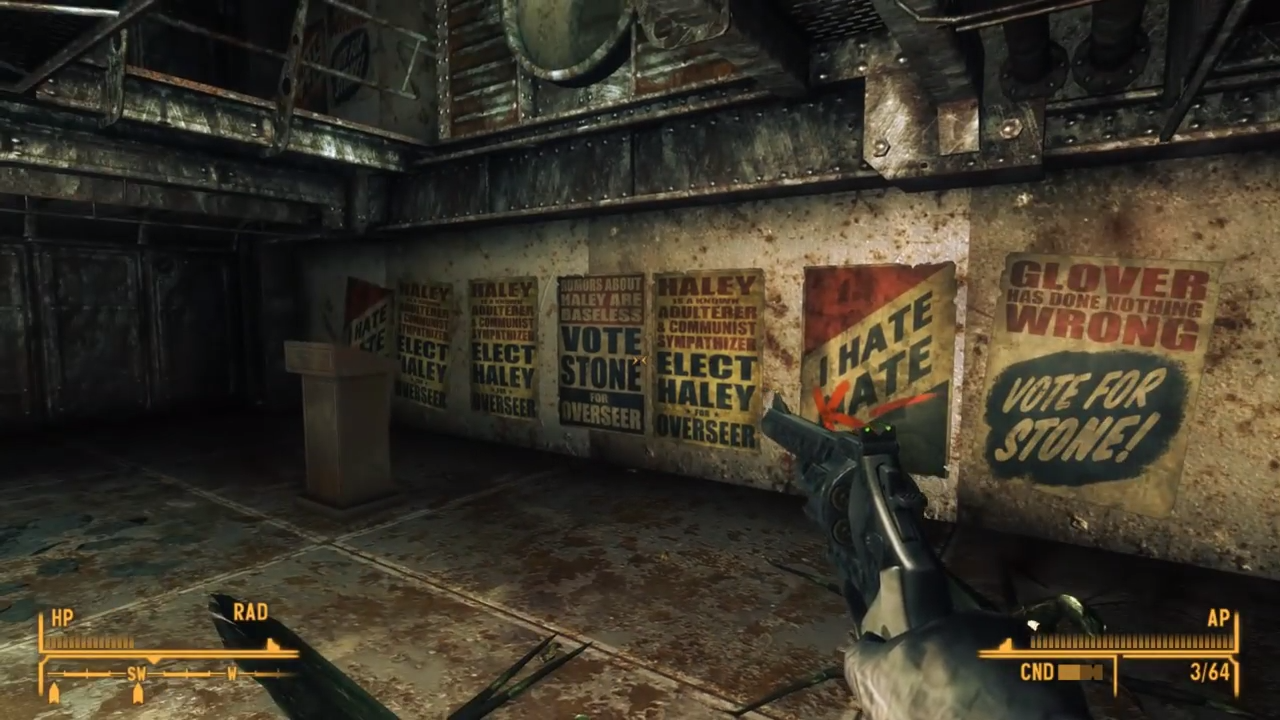
Evidently, Katherine becomes the overseer. Her first act as an overseer is to pass “Overseer Order 745”, which nullifies the election process and decrees that the overseer position would be chosen by computer’s random number generator. This gives everyone an equal chance of being elected. The Justice Bloc, worrying that one of their members would be selected and that in the long term, the vault’s social structure may change and the Justice Bloc would no longer be the most powerful voting bloc, decides to start an armed coup and demands the overseer Katherine Stone to reverse Overseer Order 745. The crowded space of Vault 11 quickly turns into battlefields for a civil war, with each bloc claiming different sections and resources, and residents taking arms shooting each other.
In the end, only five vault dwellers survive (They are the five people heard in the conversation in the audio tape at the vault entrance). In the final act of suicide, the five attempt to defy the vault computer, refusing to send in any more sacrifice. The five decide to head to the Sacrificial Chamber together and tell the computer themselves. While it is thought that their disobedience will be met with exterminating punishment, their defiance is actually the right answer:
Congratulations, citizens of Vault 11! You have made the decision not to sacrifice one of your own. You can walk with your head held high knowing that your commitment to human life is a shining example to us all. And to make that feeling of pride even sweeter, I have some exciting news. Despite what you were led to believe, the population of Vault 11 is not going to be exterminated for its disobedience. Instead, the mechanism to open the main vault door has now been enabled, and you can come and go at your leisure.
The automated response shows that there has never been any conspiracy about total extermination. Instead, Vault 11 is designed to test how far humans can go, even sacrificing one member of the community each year to ensure the survival of the whole population. The actual purpose of the vault is an experiment to see how long the population takes to defy the computer’s authority, placing morality over self-preservation. Unfortunately, the vault community is no longer there to learn the moral lesson, except for the unnamed 5 survivors. As they look around the Sacrificial Chamber, 16 skeletons of the previous overseers and sacrificed ones, executed by robots and automated guns in the chamber in order to seal the secret, remind the 5 survivors of everything they have been through, only to realize this is just a test.
On the way out, one survivor tries to convince the other four to leave the vault to let other people know and learn from this event. The four of them agree it is better that no one ever finds out about the shame that happens here. In the end, four of them shoots themselves in the head. The sole survivor of Vault 11 whimpers, drops his gun as well as his intention to die, walks through the opened vault door. No one has ever heard from him again.
A Comparative View to Shirley Jackson’s “The Lottery”
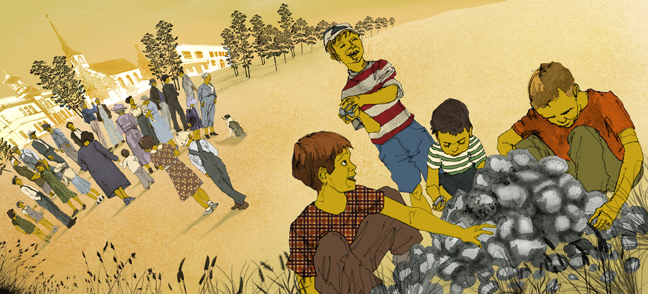
The Lottery – Illustration by Anita Steven Rundles
The lore of Vault 11 represents the story about a community that has an unquestionable trust in the system, thus doing what they are told to do and ignore conventional morality. It reminds me of the short story The Lottery by Shirley Jackson, which was an incredibly disturbing tale when it was published in the New Yorker in 1948.
In a small town of 300 people, there is a lottery held on June 27 every year and taking only two hours. At first, the village people and kids collect small stones, put them in their pockets. and make big piles out of them. Then, family proceeds to stand together, waiting for the lottery procedure to be commenced by Mr. Summers, a businessman who seems to have absolute political authority in the town. Among the town’s population, notable characters are Old Man Werner, the oldest man in town and Tessie Hutchinson, the latecomer to the lottery ritual. Old Man Werner is a firm advocate for preserving the tradition of holding the annual lottery while denouncing other villages for abandoning it, irrationally believing that without this ritual, the society will go back to a barbaric state as if the lottery is the only thing that makes the community progress. Tessie Hutchinson arrives late to the crowd, admitting she forgets what day it is. This makes her stand out in the crowd as if her misconduct on such important day is unforgivable. Then, the lottery proceeds as follows: first, each head of families (mostly husbands or adult sons) represent their families to draw a slip of paper from Mr. Summers; then, it appears that Bill Hutchinson “got it”, which means that the Hutchinson family, including the couple Bill and Tessie Hutchinson, and their three kids, is selected for the final draw; finally, the five family members enter the last draw just like the previous round. Tessie Hutchinson draws the paper with the black dot on it, meaning she is the “winner”. As the author never reveals what the lottery is about, or any intention or prize, it is only in the final paragraph that reveals the powerful and shocking ending: the villagers, including the winner’s family members, start throwing stones (which are collected by the children in the beginning in a boisterous manner) at the winner Tessie, supposedly to her death.
The lottery in Jackson’s short story bears a similarity to the annual election in Vault 11. Both involve a yearly ritual that is followed up by an irrational decision-making process of a community toward one of their fellow. Nevertheless, in The Lottery, the whole process is arbitrarily followed by villagers regardless of consequences, in the name of tradition, whereas in Vault 11, it is believed that by refusing to sacrifice one, the result may be a total extermination of everyone in the community. This comparison makes Jackson’s short story even eerier because the lottery represents any action or behavior, passed down from previous generations with no one daring to question its morality, all of which are based on a random drawing process where the participants have no means to control the outcome. Although there is no real enforcer of tradition but the collective minds of community members, going against tradition means rejecting the foundation that establishes the identity of that society. Still, there is no heavenly punishment if one decides to denounce his or her tradition, yet, people are still stoned to death in 2017 for betraying those intangible values.
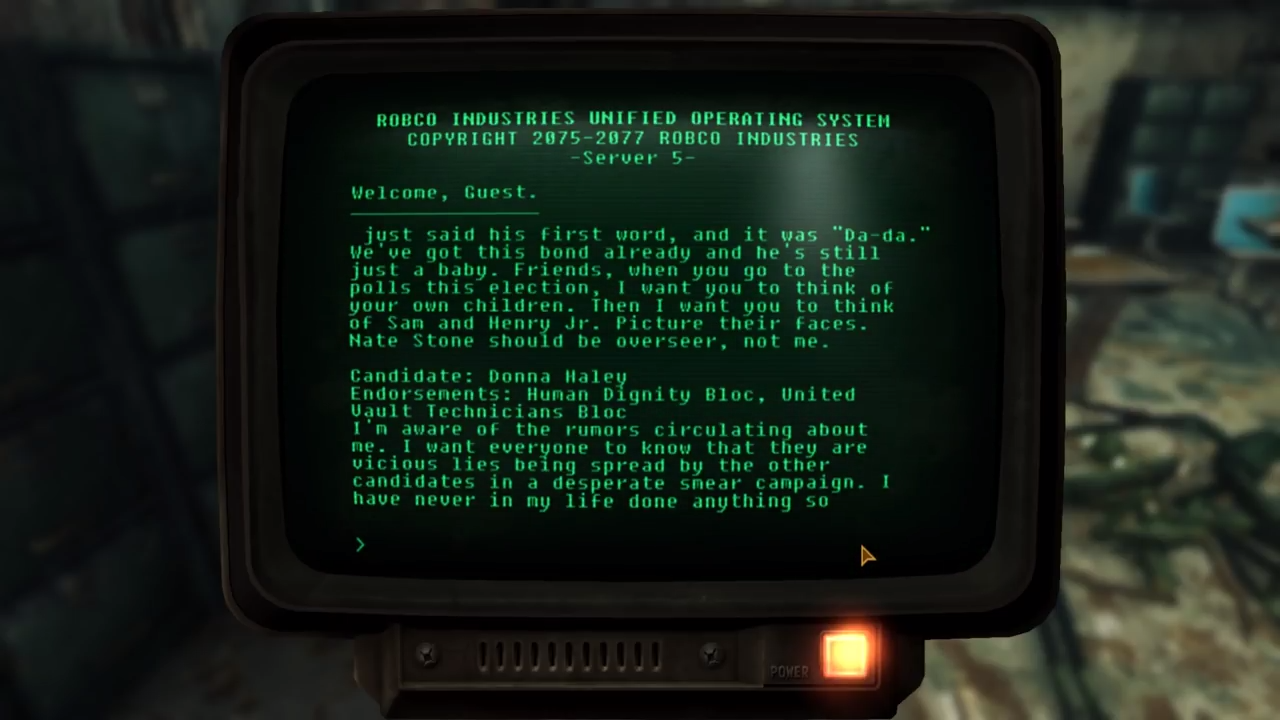
In Vault 11, the difference from The Lottery is that tradition is enforced by a tangible thing, the vault computer, and there is a (supposedly) real consequence for disobeying the tradition: the threat of extermination. The demand for self-preservation outweighs morality. While in The Lottery, the villagers show no emotional remarks toward the winner-victim and commit to their act of murder, then in Vault 11, the process of murder is conducted indirectly through elections, which establishes an illusion of democracy and equality, that is, everyone has a fair and democratic chance of getting “elected-offered” in which getting elected is equivalent to a death sentence. Hence, democracy in Vault 11 acts in a reversed way where individuals persuade the public not the vote for him or her. On the other hand, the public actively seeks an individual who breaches the vault’s propriety, such as adultery or communist sympathizing. Nevertheless, the public in Vault 11 is different from the public in The Lottery because they, the vault dwellers, do have a sense of guilt when voting for a person to become the overseer. Katherine, after murdering members of the Justice Bloc, is confident that voting for her to be the overseer is a choice “they (the public) could live with.” The guilt and shame must have filled the air in Vault 11 year after year. Yet, the survival of the whole community is the priority, and there is no point in saving one life if that action would lead to a total annihilation of the population, including that saved individual. I fail to see an alternative logic around this perspective. I ask myself when putting the lives of the vault population and of one resident on a scale, which would weigh heavier. Evidently, prolonging the inevitable faith of the population, that is, until the last surviving person of Vault 11 becomes the overseer, is a more desirable outcome.
However, things change dramatically after Katherine becomes the overseer and proposes Overseer Order 745, which nullifies the election process and uses randomization to determine the next person to be sacrificed. This turn of events transforms the story of Vault 11 into an identical version of The Lottery. Now, every resident has an equally random chance of being elected, and they no longer have to face with their sense of guilt. All of a sudden, the moral and political problem is solved though it upsets the social structure of the vault. In an absolute egalitarian society, the idea that everyone has an equal chance to be sacrificed does not appeal well to the upper class. As a result, a civil war breaks out following the issuance of Order 745. Vault 11 population destroys itself faster than the possibility of being exterminated by the vault computer.
Vault 11 and the Obedience to Authority: The Milgram Experiment
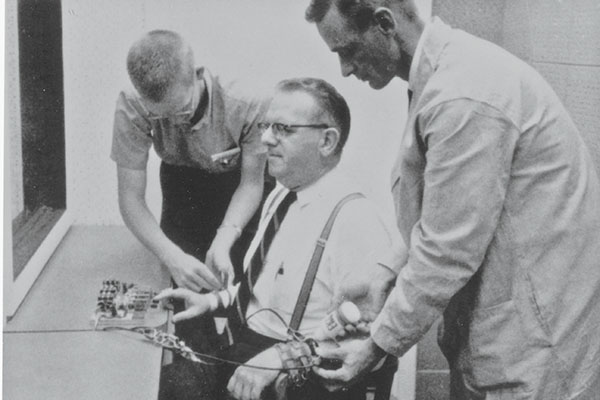
Photo: Milgram Experiment participant. Via Pacific Standard
It has always been the vault computer that is the root of all problems in Vault 11. However, the critical element surrounding the story of Vault 11 is that no one ever tries to challenge the computer’s authority. It is not a really smart and independent-thinking Artificial Intelligence as we usually see in sci-fi movies. The vault-computer is only in charge of accepting the sacrificed, disposing of it, and playing the pre-recorded response when the expected answer (which is the vault residents’ refusing further sacrifices) is achieved. Yet, the computer’s authority is blindly obliged by the vault residents (it is worth noting that at first, the residents are so angry at the first overseer for keeping the secret of the sacrifice in this vault, only letting everyone know after they are sealed inside, that they resist the overseer’s authority, throwing him into the Sacrificial Chamber, but not protesting the computer’s). Hence, the computer becomes an unquestionable authority in the vault because everyone automatically accepts the way it is. This reminds me of the infamous Milgram experiment.
The Milgram experiment, conducted in 1961 by psychologist Stanley Milgram, involved a series of tests in order to assess to what extent participants would violate their own moral codes when given an order from an authority figure. The setting is simple. There are three people involved: participant (called “teacher”), a “learner” (actually an actor installed for the experiment’s purpose), and an authority figure (experimenter). The learner-actor is strapped into an electric chair. In a different room, the participant is given a device that can give a (fake) electric shock to the learner. The two conduct a series of questions where the teacher asks, the learner answers. For each wrong answer, the learner receives a (fake) shock with an increasing degree and acts as if he is in an incredible pain. If at any time the participant wants to stop the experiment for worrying the well-being of the learner-actor, he is given a set of four consecutive commands by the authority figure:
- 1. Please continue.
- 2. The experiment requires that you continue.
- 3. It is absolutely essential that you continue.
- 4. You have no other choice, you must go on.
If the participant insists to stop after the 4th command, then the experiment is halted. Otherwise, the experiment continues after the learner-actor receives three maximum electric shocks of 450 volts (fake), which in real life could be lethal. The goal of the experiment is to test how far participants go when submitting to authority figures and hurting someone before they resist authoritative commands. The Milgram experiment raised questions about research ethics because of forcing participants to go through extreme emotional states.
In the Sacrificial Chamber of Vault 11, the player has the fortune to experience a direct reference to the Milgram experiment. The chamber only consists of a chair, a big screen in front of the chair, and a projector. The vault computer’s voice starts to give similar commands:
- Welcome. Please sit in the chair. The show is about to begin.
- The show requires that you sit in the chair.
- It is absolutely essential that you sit in the chair.
- You have no other choice. You must sit in the chair.
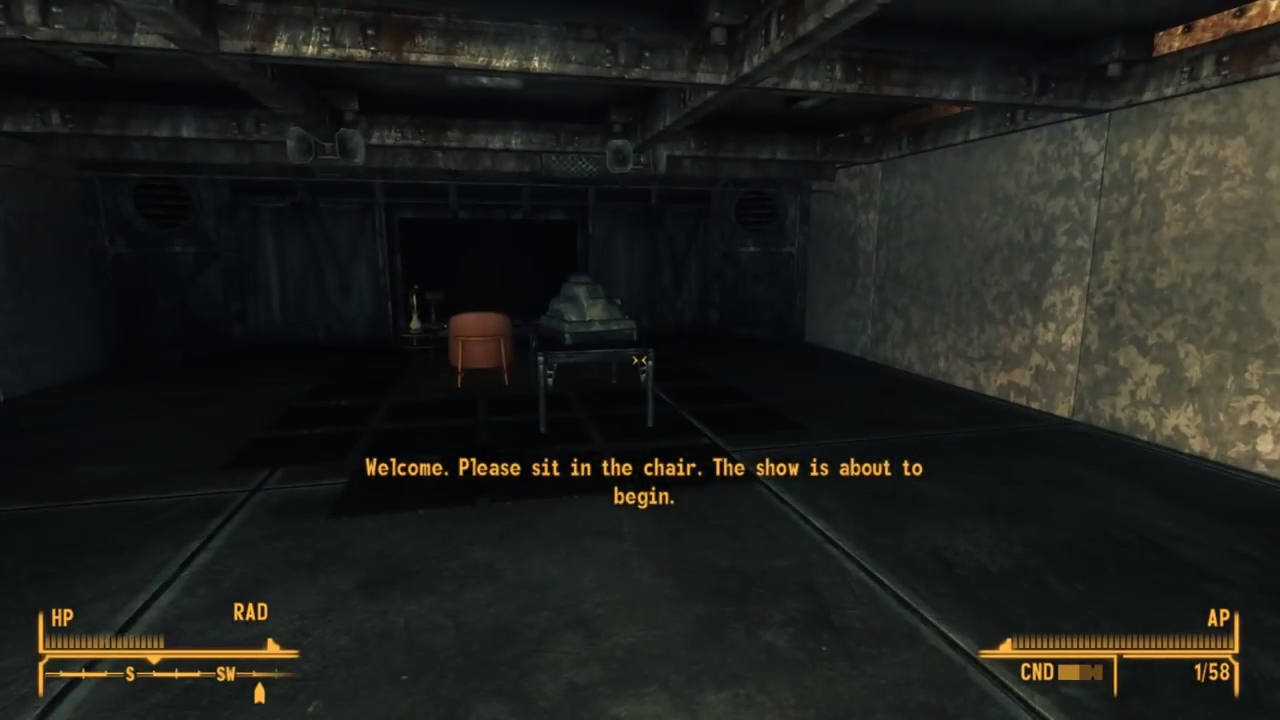
The player has to sit in the chair in order to progress. The screen starts to project a series of farewelling slides, and automated turrets and robots appear in the chamber and attack the player. This is how the vault computer leaves no witness of what happens in the Sacrificial Chamber. All the elected overseers, when entering the chamber, are killed this way.
Conclusion
The social experiment conducted in Vault 11 ends up as a disaster. As the vault society faces the threat of extermination, it creates a political and social structure that deals with the question of who to be offered. In that structure, democracy is utilized but in a reversed way: each year, an election is held for the whole community to vote for their leader, the overseer, but also to be sacrificed at the end of the overseer’s term. Everyone, each identified with a voting bloc, tries to not get voted by the majority to become the overseer. Katherine Kate, the last overseer of Vault 11, proposed Order 745 which gets rid of the absurd election and use randomization to select the next sacrificial subject. This puts the whole population at war and ends up with only five survivors. As the five survivors refuse further sacrifice, waiting to be exterminated by the computer, they learn the hard truth: they pass the moral test of Vault-Tec. The cost for this dreadful lesson is so unbearable that four of the survivors commit suicide out of shame, and the sole survivor continues to live on, hoping to let the remnant of mankind knows of this dishonorable event and not repeating the same mistake again.
There is no socially optimal outcome in this brutal social experiment. In a sealed environment and facing an exterminating threat, humanity is put to the test between self-preservation and morality. Would it be better to die together but with dignity, or to prolong the end by sacrificing one of our fellows? The desire to live is the factor that pushes the residents to cope with the harsh reality: they have to sacrifice one of their own to buy some time. However, it is this desire that drives everyone into a state of mutual destruction.
No God or authority ever wipes out mankind for disobedience, only men have been doing it to each other, and ironically, over the fear of a higher authority.